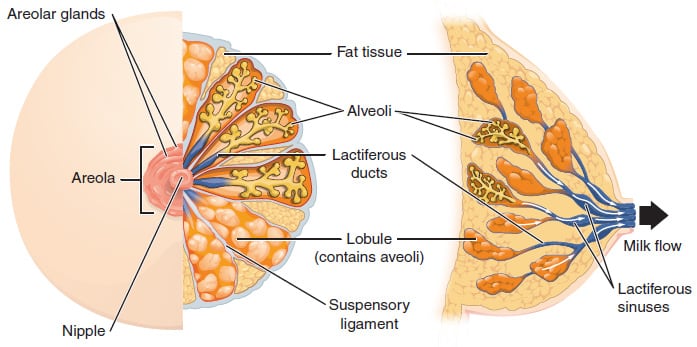Also called the uterine tubes they open into the uterus at one end and are closely related to the ovaries at the other end. They can be anatomically divided into an intramural segment that passes through the uterine wall, a narrow isthmus (high risk of rupture in an ectopic pregnancy), the widest and longest segment called ampulla (site of fertilization) and a fimbriated infundibulum that is in close relation to the ovaries. The mucosal epithelium has ciliated cells that beat towards the uterus and nonciliated secretory cells. Smooth muscle is arranged in an inner circular and outer longitudinal layer. Peristaltic movements can be seen that help to move the embryo towards the uterus. Ampulla is the most common location for an ectopic pregnancy.
They are located on either side of the broad ligament, associated with the mesovarium. Ovaries are female gonads. The surface is covered by simple cuboidal epithelium called surface or germinal epithelium. Beneath the surface epithelium is a dense connective tissue covering called the tunica albuginea. Beneath the tunica are the cortex and an inner medulla. The cortex shows a stroma with various follicles in different stages of development. The medulla contains blood vessels, nerve fibres and lymphatics.
The ovaries are connected to the uterus by the ovarian ligament. The suspensory ligament of the ovary or the infundibulopelvic ligament attaches the ovary to the pelvic sidewall. The ovaries are supplied by the ovarian artery which is a branch of the abdominal aorta. It runs in the ovarian ligament, which connects the ovary to the uterus. The right ovarian vein drains directly into the IVC while the left ovarian vein drains into the left renal vein. The left ovarian vein is prone to compression as it is longer. Compression leads to pelvic congestion and chronic pelvic pain. The left iliofemoral vessels are the most common site of thromboembolism in pregnant patients.
They are accessory organs of the female reproductive system. It lies on the pectoralis major and serratus anterior muscles, covered by skin. It is attached to the underlying muscle and overlying dermis by suspensory ligaments of Cooper. Superolaterally, breast tissue extends into the axilla as the axillary tail of Spence. Breast tissue is a mix of adipose tissue and glandular tissue. Adipose tissue is under the influence of estrogen while glandular tissue is under the influence of progesterone. Size of the breast varies depending on the content of adipose tissue while milk production is dependent on glandular tissue.

Sign up for free to take 6 quiz questions on this topic